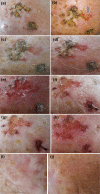Successful treatment of a unique chronic multi-bacterial scalp infection with N-chlorotaurine, N-bromotaurine and bromamine T
- PMID: 32974590
- PMCID: PMC7497830
- DOI: 10.1099/acmi.0.000126
Successful treatment of a unique chronic multi-bacterial scalp infection with N-chlorotaurine, N-bromotaurine and bromamine T
Abstract
Microbial species can act in synergy to circumvent environmental stress conditions and survive. In addition, biofilms are a serious public-health issue globally and constitute a clinical emergency. Infection persistence, increased morbidity and mortality, and antibiotic resistance are consequences of poly-microbial synergy. Due to inherited complexity and synergy between numerous species, newer antimicrobial agents of increased efficacy and tolerability are needed. In this unique medical case, a chronic (9 year) multi-bacterial scalp infection was differentially diagnosed from other inflammatory skin disorders by prolonged microbiological culture. The bacterial species found seem to have caused lesions of visible biofilm not documented previously in the medical literature. This complicated infection was treated successfully and rapidly with the combined topical application of the active halogen compounds N-chlorotaurine, N-bromotaurine and bromamine T, which is in contrast to the previous failed systemic and topical therapeutic approaches. This study strengthens the case for the use of active halogen compounds against multi-bacterial infections of the skin in the future, without the occurrence of resistance.
Keywords: N-bromotaurine; N-chlorotaurine; bromamine T; chronic multi-bacterial skin infection.
© 2020 The Authors.
Conflict of interest statement
The authors declare that there are no conflicts of interest.
Figures

References
Publication types
LinkOut - more resources
Full Text Sources
